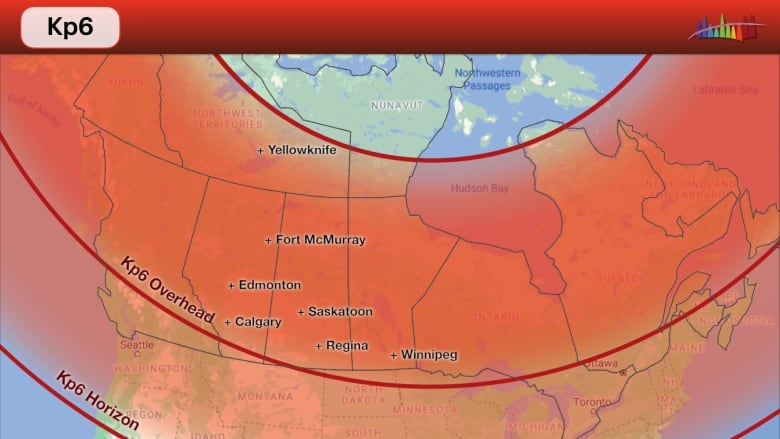Look up! You may get to see the northern lights tonight | CBC News
The sun is literally bursting with activity, which bodes well for those hoping to see the northern lights, particularly in the coming days.
Our star goes through an 11-year cycle where activity waxes and wanes. The sun has just entered a period of increased activity, specifically in the form of sunspots.
Right now, the sun is peppered with these dark, cooler regions on its bubbling surface. But these regions aren’t just cooler; they’re also more unstable.
The sun isn’t a solid mass like Earth. Instead, different parts of it rotate at different speeds. And because it has an immense magnetic field, sometimes these field lines get entangled and suddenly snap, producing a solar flare. These flares can disrupt high-frequency radio transmissions.

But there’s another special thing about solar flares: They’re also usually followed by coronal mass ejections (CMEs), an eruption of charged particles that, if they reach Earth, can interact with our magnetic field, giving us the northern lights.
And that’s exactly what happened over the weekend.
The strength of solar flares is measured from 1 to 10 for C-class and M-class flares but can go much higher for the strongest flares, X-class (the strongest ever recorded was an X28 in 2003).
On Sunday, there were two M-class flares and an X1. And shortly after, the sun burped out several CMEs that are on their way toward us. The National Oceanic and Atmospheric Administration’s Space Weather Prediction Center (SWPC) is forecasting a moderate geomagnetic storm on Monday into Tuesday. Natural Resources Canada is forecasting stormy activity in northern regions, with some heightened activity at lower latitudes within the next 24 hours.
A day makes a difference: Region 3110 flares a R2-level <a href=”https://twitter.com/hashtag/RadioBlackout?src=hash&ref_src=twsrc%5Etfw”>#RadioBlackout</a> and launches eye-candy worthy <a href=”https://twitter.com/hashtag/solarstorms?src=hash&ref_src=twsrc%5Etfw”>#solarstorms</a>. One is headed towards Earth. Impact likely early October 4. This increases <a href=”https://twitter.com/hashtag/aurora?src=hash&ref_src=twsrc%5Etfw”>#aurora</a> chances to mid-latitudes by Tuesday. Expect amateur radio & <a href=”https://twitter.com/hashtag/GPS?src=hash&ref_src=twsrc%5Etfw”>#GPS</a> reception issues. <a href=”https://t.co/kXAvjvYhmF”>pic.twitter.com/kXAvjvYhmF</a>
—@TamithaSkov
How and when … but no guarantees
All this being said, forecasting the northern lights, or aurora borealis, is difficult, as there are several factors at play.
For example, Earth has to be in the path of the CME. According to SWPC’s solar wind projection, it appears that we are at least in the way of a glancing blow.
As well, the strength of our interplanetary magnetic field needs to be strong, and the auroral hole — an invisible magnetic region around the north pole — needs to tilt southward.
If any of these things don’t happen, our likelihood of seeing them in more southern latitudes, such as Ontario, Quebec and Atlantic Canada, are lowered.
The strength of geomagnetic storms are measured on something called a Kp index that ranges from 1 to 10. The higher the number, the more likely it is that people at lower latitudes will see the northern lights. SWPC is forecasting a potential Kp index of 6.

However, that doesn’t mean you shouldn’t try to catch them if you can. There are worst things than spending a night under the stars.
The best way to see the northern lights is, of course, to get away from city lights. If you’re able to, try to get out of the city or even head to an area with a park. The farther south you are in latitude, the closer to the horizon they will appear, particularly due north, so it’s best to get a good view of the horizon.
Sometimes they’re there but are too faint and invisible to the naked eye. If you have a camera, you can try setting it up on a tripod and leaving the shutter open for a 10- to 20-second exposure at ISO 800 and see whether the camera can capture them.
And if you’re looking for updates, there are several free apps, such as Northern Light Aurora Forecast and My Aurora Forecast & Alerts, where you can keep an eye on the Kp index in real time.
You can also visit websites like Spaceweather.com and SpaceWeatherLive.
And if the forecast doesn’t come through, don’t fret: There is another enormous sunspot turning toward us that could potentially release some powerful flares within the next couple of months, so keep an eye out. As an added bonus, try looking for a bright “star” to the south. It’s not a star, but Jupiter. You can even enjoy a close-up view with a pair of binoculars.
For all the latest Technology News Click Here

